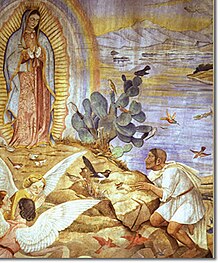Fernando Leal (artist)
Fernando Leal (February 26, 1896 – October 7, 1964) was one of the first painters to participate in the
Life
Fernando Leal was born in Mexico City on February 26, 1896.
Leal died on October 7, 1964.[1] He is survived by his son, Fernando Leal Audirac, who also became a noted Mexican painter.[3]
Career

Leal was one of the first muralists in Mexico, in a movement that began in the 1920s.
The first mural he painted was Los danzantes de Chalma at the Escuela Nacional Preparatoria, today the
The other of his best-known works is a fresco at the Anfiteatro Bolívar, painted from 1930 to 1933. It is notable for its depiction of the life of Simon Bolivar.[1][2] In the Bolivar mural, Leal combined history with fantasy in the main scene with Bolivar on horseback. The bottom shows the violence of the struggle for liberty, and features indigenous people who appear as Muses or inspiration for the hero.[4]
He also painted works which have not survived. In 1927, he painted murals at the Departamento de Salubridad, but these were destroyed.
He taught painting at the Academy of San Carlos, and in 1927 was appointed director of the Centro Popular de Pintura in Nonoalco. Its mission was to make art accessible to the working classes. In 1952 he was appointed Ministry of Culture, where he campaigned for artists´ rights in 1959.[2] He also served director of the Escuela al Aire Libre de Coyoacán.[1]
Leal was founder of the group ¡30-30!, which published a review in opposition to academic ideology in art, taking part in the group’s exhibitions starting in 1929.[2][1]
He occasionally wrote art criticism.[7] In 1952, he published El derecho de la cultura (The right of culture). He also wrote an unfinished history of the Academy of San Carlos.[1][2]
His paintings can be found in the Museo de Arte Moderno, including El hombre de la tuna (The man of the prickly pear) and Campesinos con sarape (Farm workers with sarape). (encmex) He was also a successful wood engraver.[1]
Artistry
Leal is best known for his mural work, but he also did engraving, lithography and painting on canvas.[7] He was one of the first Mexican muralists using a number of different techniques.[1] He was one of the first to create small trial versions of a work in order to find the best means of executing monumental works.[4] His murals usually used encaustic painting producing rich transparent colors, subtly graduated and free from heavy chiaroscuro .[7]
He was notable for his use of color and his early use of images from Mexican rural and popular culture.[7] His themes were mostly popular traditions and Biblical personages, one of the first to use indigenous themes for monumental work.[1][2] His work features a synthesis of shapes in the styles of Saturnino Herrán, avoiding allegory, trademarks of the Mexican realist school of paintings.[7] His artistic style was somewhere between Baroque and Classic but with use of bright colors. The base of the work was Classic but the repetition of forms is Baroque. However, his canvas works tends to be stylized with a simplification of forms in a post Impressionist style.[4]
See also
- Mexican Muralism
- Fresco
- Encaustic Painting
References
- ^ ISBN 1-56409-034-5.
- ^ a b c d e f g h i dead link "Fernando Leal , 1896-1964". Mexico City: Andres Blaisten Collection. Archived from the original on July 22, 2012. Retrieved August 5, 2012.
- ^ "Fernando Leal". Economista (in Spanish). Mexico City. January 25, 2010.
- ^ a b c d e f g Fernandez, Justino (1952). Arte Moderno y Contemporaneo de Mexico. Mexico City: Universidad Nacional Autonoma de Mexico. pp. 429–431.
- ^ ISBN 0-521-58147-8.
- ISBN 978-0826349811.
- ^ ISBN 1-884446-00-0.
